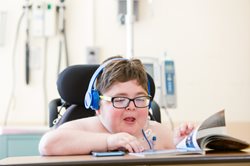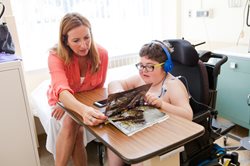Strong Kids
Not forgotten: hospital physicians work to treat, study the rarest of diseases
�鶹��Ƶ
In the beginning, the nurse could find his veins. She’d squeeze his arm and flick his skin and watch the lines of blue and purple push to the surface. But this never lasts forever. Over time, veins get harder to find, and smaller ones can collapse from overuse.��
��
This isn’t an issue if you only need a single injection. But when you need 92 of them — one each week for nearly two years — then you need another option.
��
Since April 2015, Nicholas O’Neill has traveled nearly three hours by car every week from southeast of Syracuse to Golisano Children’s Hospital. Here, in the confines of the Clinical Research Center, he sits in his wheelchair for a few more hours while nurses administer an injection to treat his Duchenne Muscular Dystrophy (DMD), a genetic disease that results in severe muscle degeneration and a life expectancy of 25 years old.��
��
These injections are part of a brand new research study. Doctors are testing a new drug that they hope will aid them in the fight against DMD. And for the first time, children who have already lost the ability to walk were invited to apply.��
��
It’s winter time, and this particular Tuesday marks Nick’s 30th visit. He now has a port installed on the left side of his chest, so nurses can easily give him injections without searching for a vein. It’s a quick procedure, but Nick must remain for several hours so nurses can monitor his vital signs and responses to the drug.��
��
 Nick, 13, of Norwich, Chenango County, gazes up at the television above him. There’s a long list of shows that he names as his favorites: Ellen, Jimmy Fallon, Agents of SHIELD, Gotham. He just finished the entire Friends series on DVD. Today, a sci-fi film has captured his interest.
Nick, 13, of Norwich, Chenango County, gazes up at the television above him. There’s a long list of shows that he names as his favorites: Ellen, Jimmy Fallon, Agents of SHIELD, Gotham. He just finished the entire Friends series on DVD. Today, a sci-fi film has captured his interest.
��
His big eyes shift downward to the applesauce in front of him. He lowers his head to just above the container, to give his arm the shortest possible route from table to mouth.��
��
His mother, Allison, watches quietly as he looks back up at the television.��
��
A lonely diagnosis��
��
The National Organization for Rare Disorders has a threshold for the diseases that qualify for its official classification of “rare.” To earn that designation, a disease has to affect fewer than 200,000 people at any given time.��
��
DMD is only found in 15,000 children and young adults at any given time.��
��
“It’s the most common muscular dystrophy in children, but still a very rare disease overall so best care is available only in a few special centers,” said Emma Ciafaloni, M.D., professor of Neurology and Pediatrics at the �鶹��Ƶ, who treats Nick O’Neill and is among the researchers running the clinical trial.
��
A disease of this rarity and sophistication can’t be properly treated by a pediatrician, or even a single specialist. Instead, a team of doctors spanning several subspecialties are required to ensure a patient receives the best care.��
��
��

In addition to Ciafaloni, patients with DMD at Golisano Children’s Hospital also see pediatric pulmonologist Karen Voter, M.D., for the breathing issues that tend to develop in late childhood. Pediatric endocrinologist David Weber, M.D., sees them for growth and bone management issues. And they go to pediatric cardiologist Carol Wittlieb-Weber, M.D., who monitors their hearts, which can become weaker due to DMD.
��
“If you have Duchenne’s and you live in the northeast, you come here, or Cincinnati, or Pittsburgh, or New York City, and that’s it,” said Ciafaloni. “It really does take a village to care for these kids, and that’s a very difficult thing to have unless you are an institution of this caliber.”
��
DMD is among several rare diseases that are studied within the hospital’s Neuromuscular Division and the Division of Child Neurology. Most notably, the division is home to the University of Rochester Batten Center, where physicians treat and study Batten Disease, a fatal disorder of the nervous system that begins in childhood. It is estimated that less than 1,000 people in the United States are living with Batten Disease at any given time.��
��
But while efforts are being made, advances can be slow. There aren’t the same resources available to study diseases such as DMD compared with more common ailments, meaning money for research is scarce and new treatments don’t come along very often.��
��
And even within a disease that is already tremendously uncommon, there are a variety of different mutations. Nick’s mutation only occurs in 13 percent of DMD patients.��
��
Hope for the future
��
This means Nick’s affliction represents a rare subset within one of the rarest of rare diseases. But at Golisano Children’s Hospital, these patients are not forgotten.��
��
The clinical trial that Ciafaloni is helping to run focuses on this exact subset of patients. Only 24 children are participating, and to find these patients, doctors had to search all over the country. Nick was one of them.��
��
“We feel so lucky that we’re able to just come here for this — it’s been one of the first positive things we’ve had to focus on in years. We would’ve gone anywhere to participate,” said Allison O’Neill. “This medication, if it works, it’s not going to help him stand or walk again, but we’re hoping that he can eat, and hold his books, and play videogames, and write and draw.”
��
And on a Wednesday in June – Nick’s 58th visit — there are already several gains from the winter. Instead of lowering his head to the table to eat, he can bring his hand all the way up to his mouth. When he goes to the movies, he doesn’t need to rely on his mother to give him his popcorn any more. If he gets uncomfortable while sitting or in bed, he can more easily shift himself instead of needing to call for help.
��
“The things they’re doing now with kids who are first diagnosed is much more advanced now than it was a decade ago,” said Allison O’Neill. “I wish we knew some of the things then that we know now, because maybe Nick would still be walking.”
��
But Allison O’Neill keeps sending her son back for treatment every week. Both for his sake, and for all the Nicholas O’Neills of the future.��

